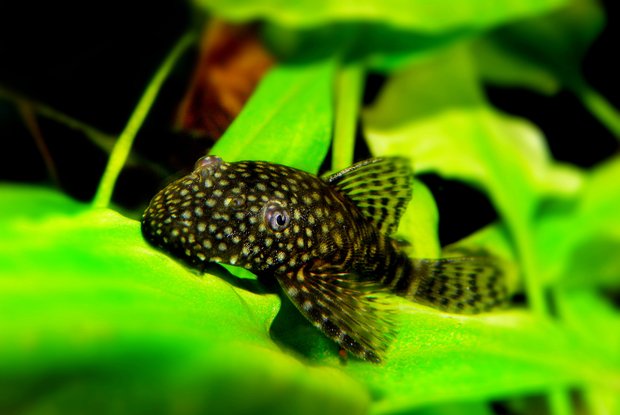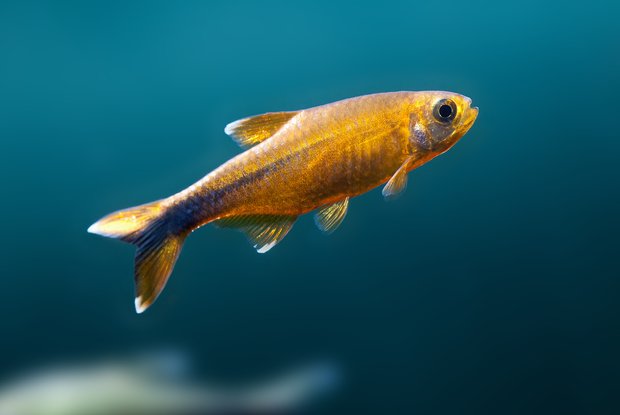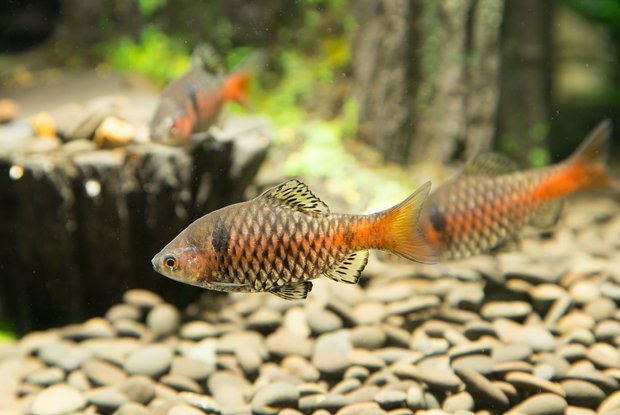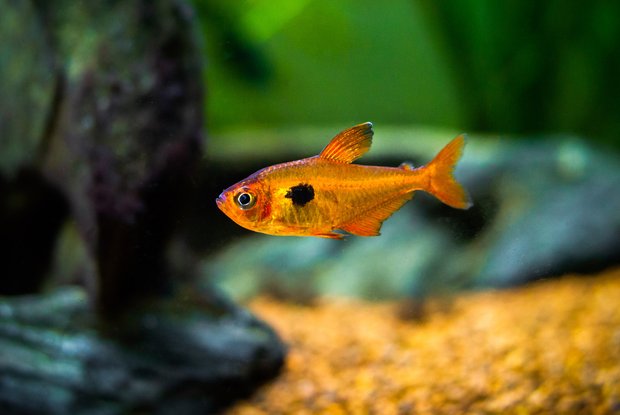
Blood tetra
Size: approx. 3-4cm
Life expectancy: up to 5 years
Origin: South America
Difficulty: medium
Water temperature: 22 - 28 °C
pH-value: approx. 6 - 7,5
Food: live and dry food
tank size: min. 150 liters
Keeping: schooling fish (min. 10 animals)
Blood tetras have an elongated and laterally strongly flattened physique. The main characteristic of the Blood Tetra is its striking reddish base coloration, with a black spot behind the gill covers, which may fade in adults. The fins are black in places. When the Blood Tetra is comfortable, its red coloration intensifies, but fades when frightened or uncomfortable.
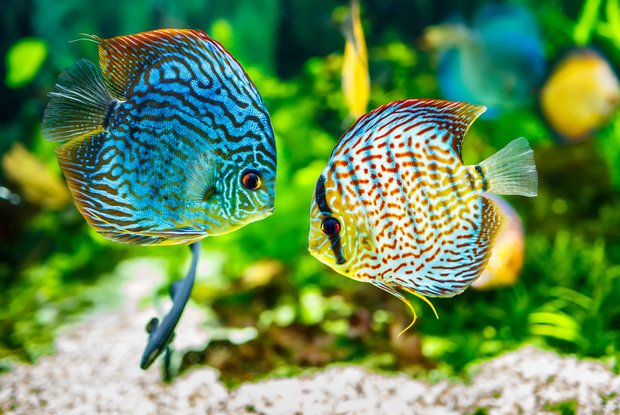
Discus
Size: 12-15 cm
Life expectancy: up to 14 years
Origin: South America, Amazonia
Difficulty: difficult
Water temperature: 26 - 30 °C
pH-value: approx. 5 - 7,5
Food: live, frozen and granulated food (very varied food)
Tank size: min. 150 cm length / 350 liters
Keeping: group keeping (min. 6 animals)
Discus fish have an impressive size and a striking appearance. They are named after their almost round, disc-shaped body. Another striking feature is also their bright colors and varied patterns, which make the Discus a very popular aquarium inhabitant. The colors and patterns can vary depending on the age, sex and mood of the fish. Overall, discus are beautiful fish, but are not recommended for beginners due to their demanding needs and high price.
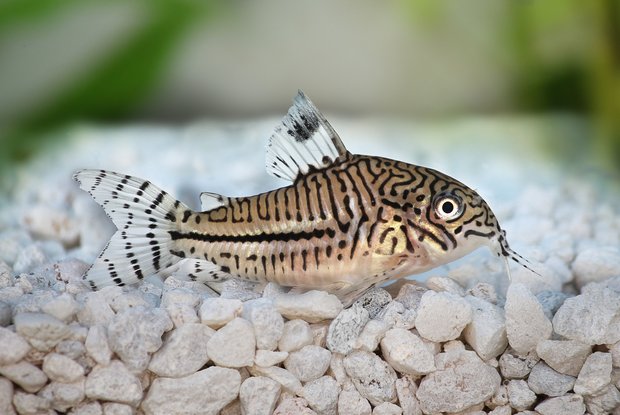
Three-stripe corydoras
Size: 5-6 cm
Life expectancy: up to 10 years
Origin: South America, Peru, Ecuador
Difficulty: medium
Water temperature: 23 - 27 °C
pH-value: approx. 6 - 7.5
Food: live, frozen and dry food
Tank size: at least 60 cm long / 80 liters
Keeping: group keeping (at least 5 animals)
The characteristic appearance of the three-stripe corydoras consists of a silvery or yellowish basic coloration with a conspicuous black longitudinal band down the middle of the body flanks. The rest of the body is drawn with dark dots, irregular lines, or dashes. Its fins are colorless, almost transparent, with dark lines running through the caudal and anal fins and the upper third of the dorsal fin is black. There are short pairs of barbels around the mouth of the three-line armored catfish. Female specimens are slightly larger and appear more massive than males. In addition, they are less marked and the black spot on the dorsal fin is smaller.
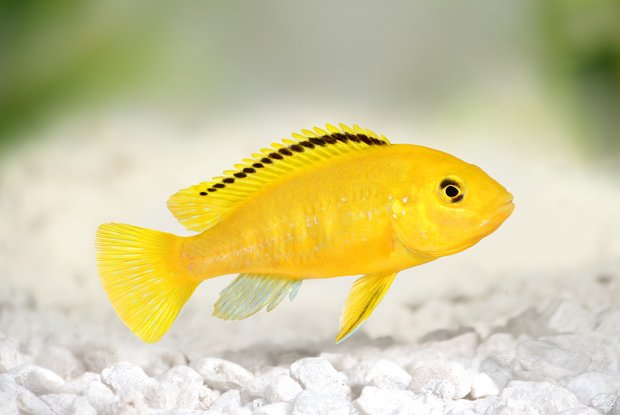
Yellow Labidochromis
Size: about 10 cm
Life expectancy: up to 10 years
Origin: Africa, Lake Malawi
Difficulty: medium
Water temperature: 24 - 26 °C
pH-value: approx. 7,5 - 8,5
Food: live, flake and dry food
Tank size: min. 120 cm length / 250 liters
Keeping: harem keeping
The Yellow Labidochromis, also called Yellow Lab, has an elongated and laterally flattened body. Its basic coloration is yellowish-orange, but there are also breeding forms in blue or silvery-white. The broad black longitudinal band running through its dorsal fin is a characteristic feature. The anal and ventral fins are yellowish to whitish and fringed with black at the bottom. Due to its bright coloration and elongated body, the Yellow Labidochromis is a real eye-catcher in the aquarium.
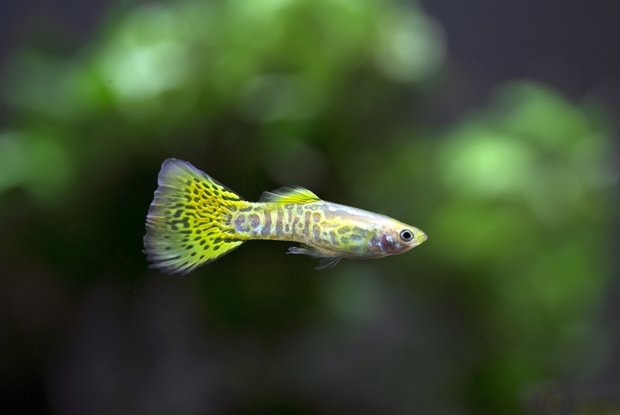
Guppy
Size: 3-5 cm
Life expectancy: up to 4 years
Origin: South America, North Brazil, Venezuela
Difficulty: easy
Water temperature: 20 - 26 °C
pH-value: approx. 6 - 8,5
Food: omnivorous, live and dry food
Tank size: at least 60 cm length
Keeping: peaceful, group keeping (min. 5 animals)
Guppies are one of the best known and most commonly kept freshwater fish species. They are popular with many aquarists because of their bright colors and patterns and are often recommended as beginner fish. Guppies have an elongated, slender body shape and can vary in color depending on the species and breeding form. Males often have flashy colors and patterns, while females are more nondescript. Guppies can come in a variety of colors such as red, blue, yellow, green or black and often have ornamentation such as spots or stripes. The caudal fin of males is often particularly striking and may have iridescent colors or be pronounced in a special shape such as a fan or triangle.
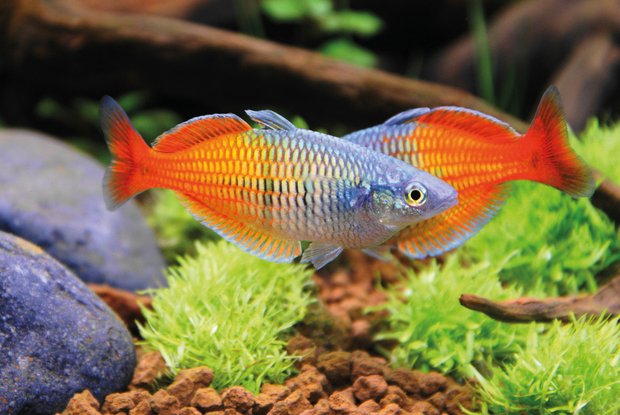
Boeseman's rainbowfish
Size: about 8-12 cm
Life expectancy: up to 12 years
Origin: New Guinea
Difficulty: medium
Water temperature: 24 - 27 °C
pH-value: approx. 7 - 8
Food: balanced mixture of dry, frozen and live food
Tank size: at least 100 cm length / 250 liters
Keeping: schooling fish (approx. 8-12 animals)
The Boeseman's rainbowfish impresses with its laterally flattened body structure and a pointed head with relatively large eyes and a small, almost terminal mouth with thickened lips. The anterior half of the body including the head, pectoral and pelvic fins shimmer silvery to bluish, while the posterior half of the body including the posterior fins shine a bright orange-red. The middle of the body shows alternating dark and light vertical bands, while females have a more greenish shimmering coloration and have narrow, reddish-orange horizontal stripes in the posterior half of the body.
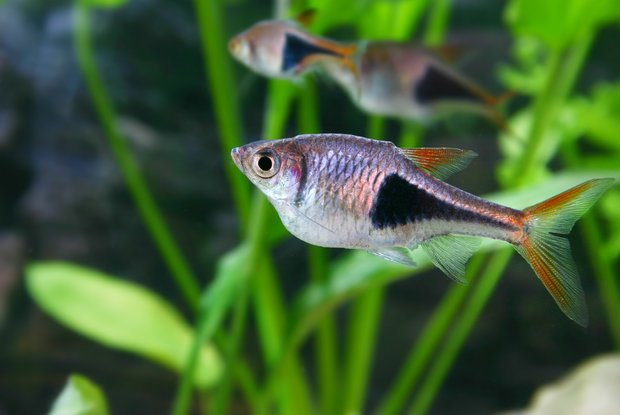
Harlequin rasbora
Size: about 4-5 cm
Life expectancy: up to 7 years
Origin: Southeast Asia, especially Thailand
Difficulty: easy
Water temperature: 22 - 26 °C
pH-value: approx. 6 - 7
Food: live and dry food, smaller food types
Tank size: at least 100 liters
Keeping: school fish (at least 8 individuals)
The Harlequin rasbora is characterized by its squat, laterally compressed body and a silvery, reddish, or golden coloration with metallic shimmering scales. The head, gill cover, and tail fin stem are more intensely colored than the rest of the body. Its name is derived from the dark wedge-shaped spot that extends from the dorsal fin to the tail fin. Male specimens display dark stripes on the anal fin, whereas in females, it is completely transparent.
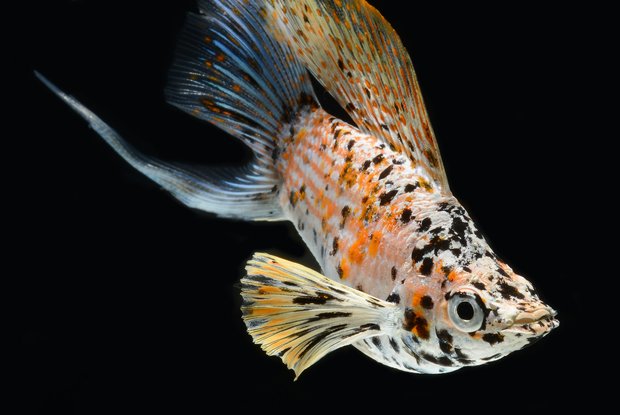
Molly
Size: 5-10 cm
Life expectancy: 3-5 years
Origin: Mexico, Guatemala, Honduras
Difficulty: easy
Water temperature: 24 - 28 °C; they prefer hard water with a higher salt content, therefore it is often advisable to add some salt to the aquarium water.
pH-value: approx. 7 - 8
Food: live and dry food, prefer plant food
Tank size: at least 80 cm length
Keeping: group keeping (at least 5 individuals)
Mollies have an elongated body shape and come in many different colors and patterns. Males are often smaller and more colorful than females and have an elongated fin called a gonopod, which they use for reproduction. Some mollies also have a noticeable fin shape, such as a split or triangular dorsal fin.
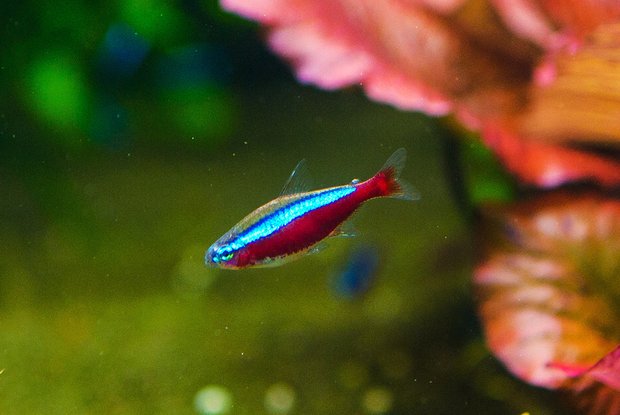
Neon tetra
Size: about 4 cm
Life expectancy: up to 8 years
Origin: Upper Amazon basin
Difficulty: easy
Water temperature: 20 - 25 °C
pH-value: approx. 5 - 7,5
Food: live, frozen and flake food
Tank size: at least 60 cm length
Keeping: peaceful, schooling fish (at least 10 individuals)
The most characteristic feature of the Neon Tetra is its striking coloration. It owes its name to the bright blue stripe on the side, which is reminiscent of a neon tube due to light reflection and makes the fish "glow". Neon tetras are originally native to the waters of the Amazon. The reflections of the individual animals therefore not only has the advantage of keeping the shoal together in murky water, but also of deterring potential predators.
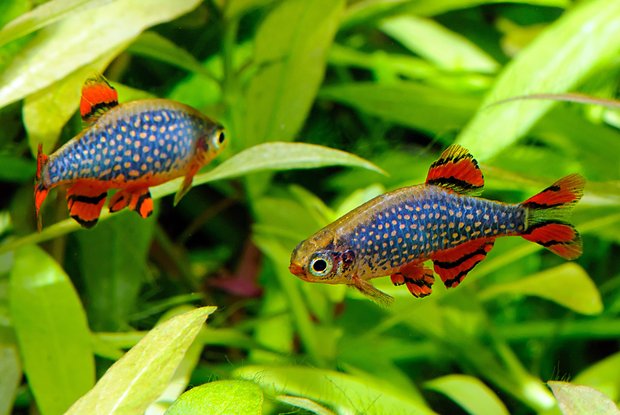
Celestial pearl danio
Size: approx. 2.5 cm
Life expectancy: up to 3 years
Origin: Southeast Asia (Myanmar and Thailand)
Difficulty: easy
Water temperature: 20 - 25 °C
pH-value: approx. 6,5 - 7,5
Food: omnivorous (dry food, live food)
Tank size: at least 54 - 60 liters
Keeping: peaceful, schooling fish (at least 8 individuals), shy, need hiding places, dense border planting and sufficient swimming area
Celestial pearl danios are characterized by a striking, colorful pattern. Their flanks are blue-gray with bright, pearl-like spots. The back and belly are light brown, ocher or slightly reddish. The fins of the male are bold red with black stripes. The females, on the other hand, appear somewhat paler, and their anal fin is transparent or only lightly colored.
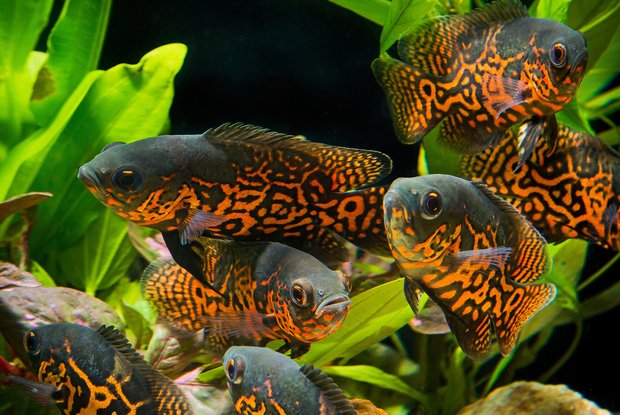
Tiger Oscar
Size: up to 40 cm
Life expectancy: up to 17 years
Origin: South America, Amazon region
Difficulty: medium
Water temperature: 22 - 27 °C
pH-value: approx. 6,5 - 7,5
Food: live food, frozen food and occasionally plant food
Tank size: at least 150 cm length / 500 liters
Keeping: in pairs
The best known breeding form of the Velvet Cichlid is the Tiger Oscar, a large freshwater fish with a very characteristic appearance. The basic color of the body is dark gray or black, with numerous white, yellow and orange spots and stripes. The fins are often colored red or orange, while the eyes have conspicuous orange spots.
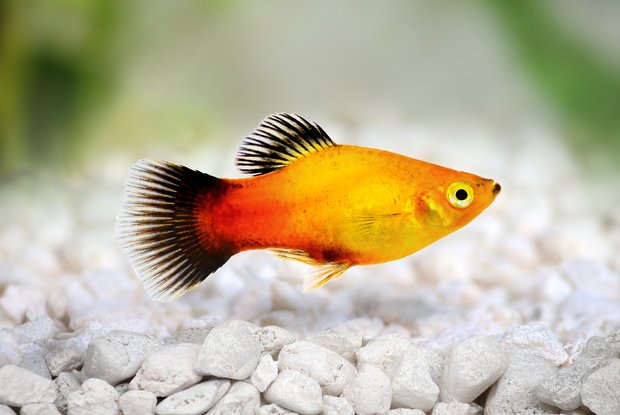
Platy
Größe: 4-6 cm
Lebenserwartung: 2-4 Jahre
Herkunft: Mexiko, Guatemala, Honduras
Schwierigkeit: einfach
Wassertemperatur: 18 - 25 °C
pH-Wert: ca. 7 – 8
Futter: Lebend- und Trockenfutter
Beckengröße: mind. 60 cm Länge
Haltung: Gruppenhaltung (mind. 5 Tiere)
Platys haben einen längliche, abgeflachten Körper mit einem hohen Rücken. Es gibt sie in den verschiedensten Farben und Musterungen, von Gelb, Orange, Grün bis hin zu Schwarz. Die Flossen der Platys sind oft sehr auffällig und können in verschiedenen Formen ausgeprägt sein, wie zum Beispiel einem Fächer oder einer Spitze. Insgesamt sind Platys sehr hübsche und bunte Fische, die eine Bereicherung für jedes Süßwasseraquarium darstellen können.
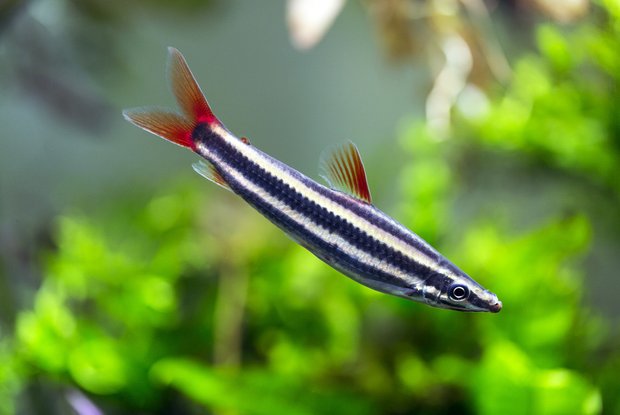
Prachtkopfsteher
Größe: ca. 13-18cm
Lebenserwartung: bis 15 Jahre
Herkunft: Südamerika, Amazonas und Orinoco
Schwierigkeit: mittel
Wassertemperatur: 24 - 28 °C
pH-Wert: ca. 6 – 7,5
Futter: vor allem Pflanzenkost
Beckengröße: mind. 100 cm Breite / 300 Liter
Haltung: Gruppenhaltung (mind. 6 Tiere)
Der Prachtkopfsteher hat einen langgestreckten Körper mit drei dunklen Streifen, welche vom Kopf bis zur Schwanzwurzel verlaufen. Diese werden von zwei hellgelben Bändern voneinander getrennt. Ein weiteres Merkmal sind die auffallend roten Flossen.
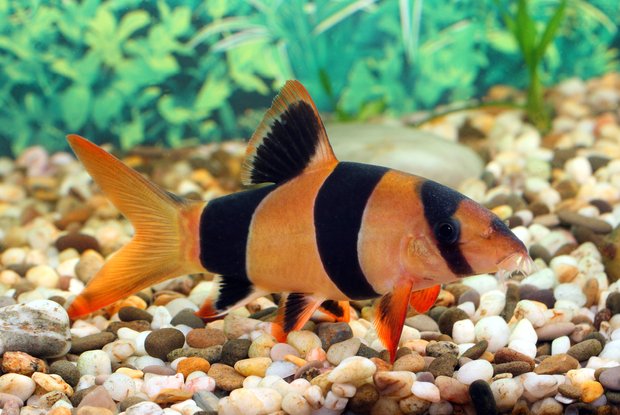
Prachtschmerle
Größe: bis zu 30 cm
Lebenserwartung: bis zu 20 Jahre
Herkunft: Indonesien (Sumatra und Borneo)
Schwierigkeit: normal
Wassertemperatur: 24 - 28 °C
pH-Wert: ca. 6,0 - 7,5
Futter: Allesfresser (Frostfutter, Lebendfutter, Futtertabletten)
Beckengröße: mind. 150 cm / 350 Liter
Haltung: Gruppenhaltung (mind. 5 Tiere), friedlich, schwimmfreudig, benötigen genügend Platz, Pflanzen und Unterschlupf
Prachtschmerlen wühlen auf der Suche nach Nahrung gerne den Bodengrund auf, weshalb auf scharfkantigen Kies verzichtet werden sollte. Charakteristisch für die Prachtschmerle ist die schwarz-orange Zeichnung, die im vegetationsarmen Bodenbereich ihrer Heimatgewässer zur Tarnung dient. In einer Hauttasche unter den Augen liegen scharfe Augendornen, welche sich ausklappen lassen und der Abwehr von Fressfeinden dienen.
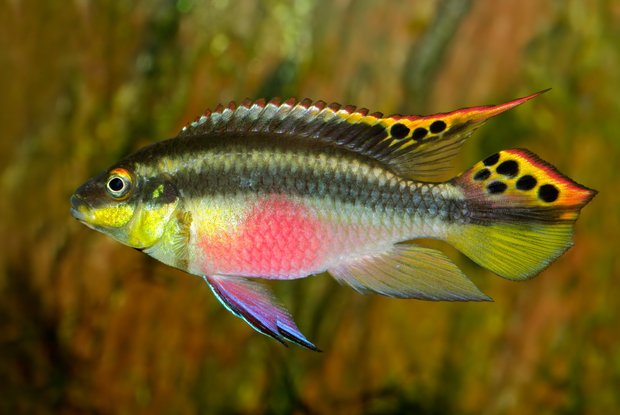
Purpurprachtbarsch
Größe: 8-10 cm
Lebenserwartung: bis 9 Jahre
Herkunft: Westafrika
Schwierigkeit: mittel
Wassertemperatur: 23 - 26 °C
pH-Wert: ca. 6 – 7,5
Futter: Lebend- und Frostfutter
Beckengröße: mind. 80 cm Länge / 150 Liter
Haltung: Paarhaltung
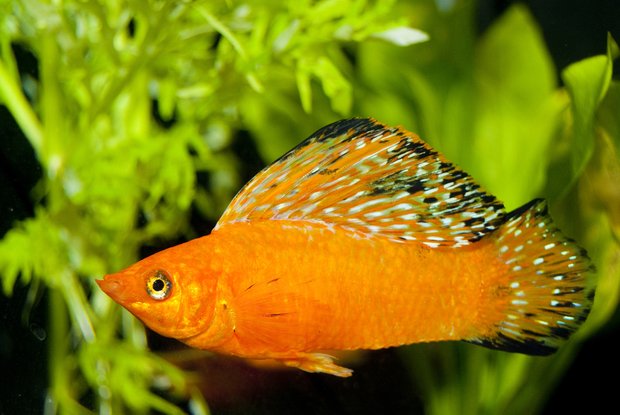
Segelkärpfling
Größe: bis zu 15cm
Lebenserwartung: bis 6 Jahre
Herkunft: Mittelamerika, südöstliches Mexiko
Schwierigkeit: einfach
Wassertemperatur: 24 - 28 °C
pH-Wert: ca. 7,5 – 8,5
Futter: Allesfresser, Pflanzennahrung (wichtig!)
Beckengröße: mind. 120 cm Breite / 250 Liter
Haltung: Gruppenhaltung (mind. 5 Tiere)
Charakteristisch und auch namensgebend für diese Art ist das große und auffällige Segel, das sich auf dem Rücken des Männchens befindet. Die Grundfarbe des Körpers ist meist silbrig, beige oder goldbraun. Die Weibchen sind eher unauffällig gefärbt und haben normalerweise eine viel kleinere Rückenflosse.
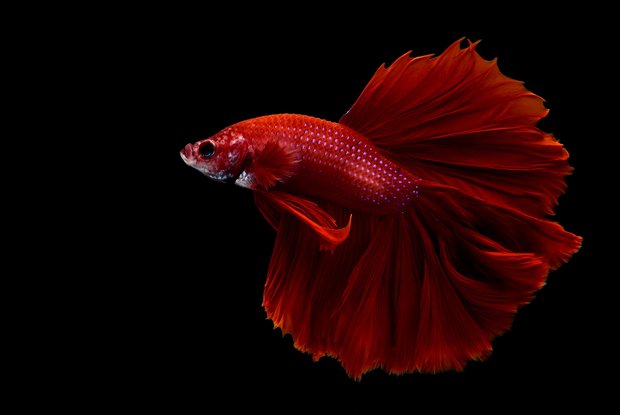
Siamesischer Kampffisch
Größe: 5-7 cm
Lebenserwartung: bis 3 Jahre
Herkunft: Südostasien, Thailand, Kambodscha
Schwierigkeit: mittel
Wassertemperatur: 24 - 30 °C
pH-Wert: ca. 6 – 7,5
Futter: Lebend-, Frost- und Trockenfutter
Beckengröße: mind. 60 cm Länge
Haltung: Einzelhaltung
Siamesische Kampffische sind bekannt für ihre leuchtenden Farben und langen Flossen. Es gibt eine Vielzahl von Farben und Mustern, darunter Rot, Blau, Grün, Gelb, Schwarz, Weiß u.v.m. Männliche Kampffische haben in der Regel längere und ausgeprägtere Flossen als Weibchen. Siamesische Kampffische sind insgesamt sehr schön anzusehen und werden oft wegen ihres beeindruckenden Aussehens gehalten.
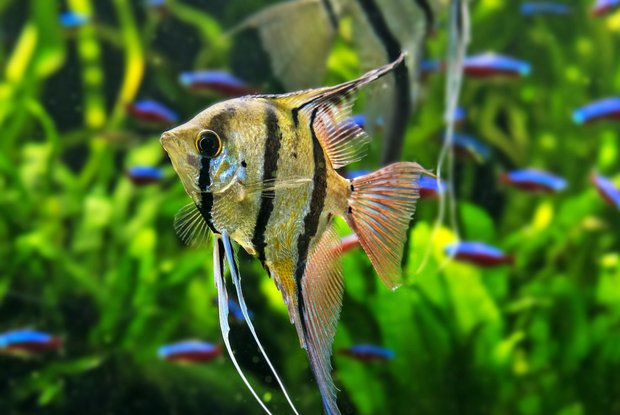
Skalar
Größe: 10-15 cm
Lebenserwartung: bis zu 15 Jahre
Herkunft: Südamerika
Schwierigkeit: mittel
Wassertemperatur: 25 - 30 °C
pH-Wert: ca. 6 – 7,5
Futter: Lebend- und Frostfutter
Beckengröße: mind. 250 Liter
Haltung: Gruppenhaltung in hohen Becken mit großen Wurzeln
Skalare sind bekannt für ihre eleganten und auffälligen Körperformen. Sie haben eine dreieckige Körperform und einen hohen Rücken mit langen Flossen, die sie beim Schwimmen majestätisch ausbreiten können. Skalare gibt es in verschiedenen Farben wie Silber, Schwarz, Weiß, Gold oder Kupfer und besitzen oft auffällige Streifen oder Flecken auf ihren Flossen.
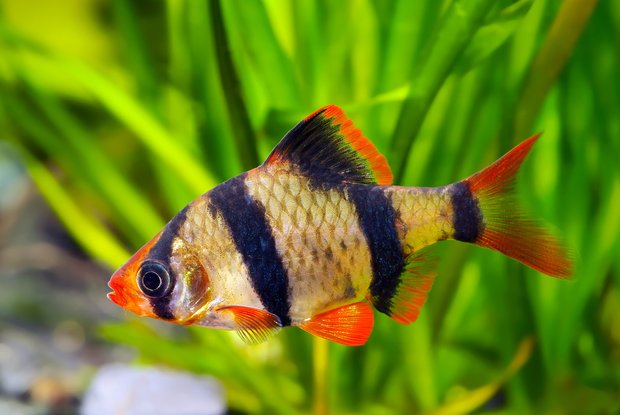
Sumatrabarbe
Größe: ca. 6-7cm
Lebenserwartung: bis 7 Jahre
Herkunft: Südostasien
Schwierigkeit: mittel
Wassertemperatur: 24 - 26 °C
pH-Wert: ca. 6 – 7,5
Futter: Pflanzen-, Lebend- und Trockenfutter
Beckengröße: mind. 100 cm Breite / 150 Liter
Haltung: Gruppenhaltung (mind. 8 Tiere)
Die Sumatrabarbe hat ein friedliches Sozialverhalten und zeigt keine Aggressionen gegenüber anderen Fischarten. Ihr Aussehen ist durch ihre markante schwarze Binde auf gelb-orangem Grund gekennzeichnet. Ein weiteres Merkmal sind die rötlichen Flossen unten am Bauch.
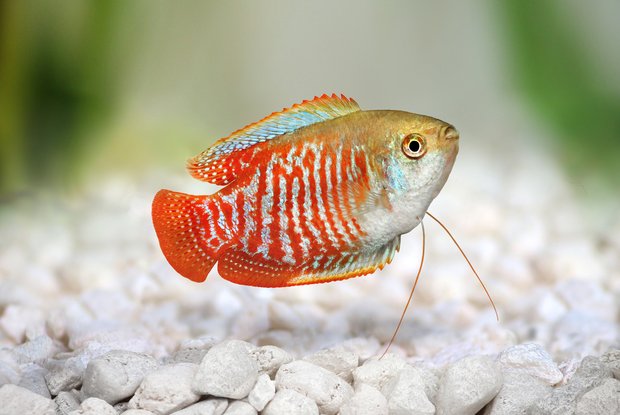
Zwergfadenfisch
Größe: ca. 5 cm
Lebenserwartung: ca. 3 Jahre
Herkunft: Südasien/Indien (Flussgebiet am Ganges & Brahmaputra)
Schwierigkeit: einfach
Wassertemperatur: 24 - 28 °C
pH-Wert: ca. 6,0 - 7,5
Futter: Allesfresser, sofern er es verschlucken kann (Trockenfutter, Frostfutter und Lebendfutter)
Beckengröße: mind. 80 cm / 112 Liter
Haltung: Paar- oder Haremshaltung; relativ friedlich, Männchen jedoch revierbildend; großzügige Bepflanzung als Rückzugsort
Zwergfadenfische haben ein Labyrinthorgan, durch das sie Sauerstoff an der Wasseroberfläche aufnehmen und daher auch in sehr warmem und sauerstoffarmem Wasser leben können. Besonders die Männchen fallen durch ihren leuchtend orangeroten Körper und den türkisen Längsstreifen auf. Charakteristisch sind außerdem die Fäden am Bauch, bei denen es sich um ausgezogene Hartstrahlen der Bauchflossen handelt.

